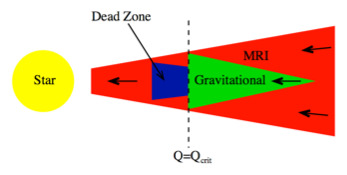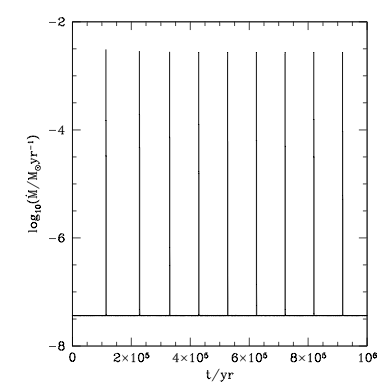The Gravo-Magneto Disc Instability



The dead zone is heated by self gravity until it reaches the critical temperature required for the MRI, Tcrit. The MRI is triggered causing an accretion outburst.
Mass builds up and the dead zone becomes self gravitating.
The disc empties, cools and the dead zone forms again.



Outburst Phase
The dead zone acts like a plug in the accretion flow. Material can only flow through the surface layers and thus the disc is not steady. Material builds up within the dead zone until the outer parts become self-gravitating. The self-gravity generates some additional turbulence that heats the disc.
The heating from the self-gravity eventually triggers the MRI when the disc reaches the critical temperature, Tcrit. Material in the disc accretes on to the star in an accretion outburst where the luminosity of the star may increase by several orders of magnitude. As the material drains out, the disc cools and the dead zone forms again. Providing that there is sufficient infall on to the disc, the cycle repeats.
1.
3.
2.
If the infall accretion rate on to a protoplanetary disc is very large, there may be a steady state self-gravitating disc solution. If the accretion rate is very small, there may be a fully MRI active steady state. However, for a range of accretion rates there is no such steady disc solution. The disc contains a dead zone and is gravo-magneto unstable.
Limit Cycle
We have explained this disc instability with a limit cycle similar to that used to explain dwarf nova outbursts in cataclysmic variables (e.g. Bath & Pringle 1992).

Externally ionised MRI
Dead Zone
GM
Thermally ionised MRI
We plot the steady state disc solutions at a fixed radius in the disc (R=3AU here). The limit cycle shows the accretion rate through the disc (or equivalently, the surface temperature) against the surface density.
The thick lines show the steady state solutions The externally ionised MRI disc solutions lie in the bottom left corner, where the surface density is small. The thermally ionised solutions with T>Tcrit lie in the upper right where the temperature is high. The gravo-magneto solutions (self gravitating dead zone with MRI active surface layers) lie on the bottom right where the surface density is high but the temperature is low. The dead zone branch is shown as a dashed line because it is not a steady branch, but it connects the externally ionised MRI branch to the GM branch.
At the upper end of the GM branch and the lower end of the thermally ionised MRI branch, the mid plane temperature of the disc solution is the same. However, there is a range of accretion rates between these two solutions for which no steady state solution exists. If the infall accretion rate lies in this range, the disc is gravo-magneto unstable and the disc transitions between the GM and thermally ionised solutions, thus displaying outburst behaviour. The thin line with arrows shows the evolution of a time-dependent disc.
GM Unstable

Accretion Outbursts
When the disc is GM unstable, the result is large accretion outbursts on to the central star. Below is a plot of the accretion rate on to the central star as a function of time. These outbursts are thought to explain observed FU Orionis outbursts and are also likely to take place in circumplanetary discs around forming gas giant planets (Lubow & Martin 2012).
Martin & Lubow (2011, 2013)

T=Tcrit
T=Tcrit